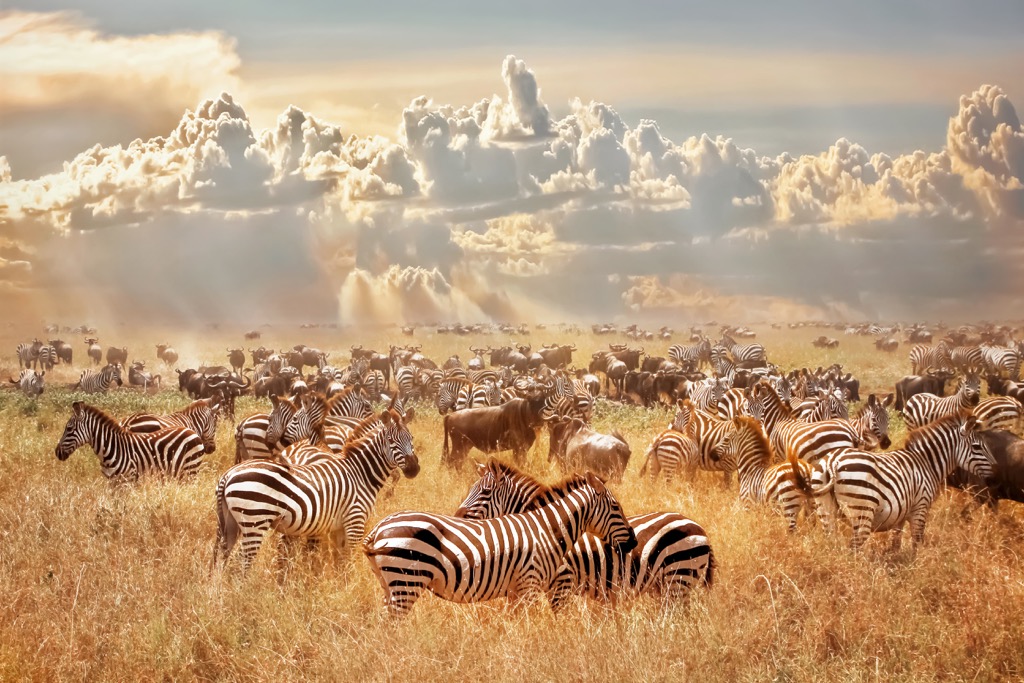Serengeti National Park
Serengeti National Park, located in northern Tanzania, is one of the world’s most iconic and breathtaking wildlife destinations. Covering an immense area of approximately 5,700 square miles (14,763 square kilometers), the park is famous for its vast savannas, stunning landscapes, and rich biodiversity. It’s not only a haven for wildlife but also a testament to the power and beauty of nature in its purest form.

The Serengeti is perhaps best known for the Great Migration, one of the most spectacular natural phenomena on Earth. Every year, millions of wildebeest, zebras, and gazelles travel across the park in search of fresh grazing grounds. This migration, often referred to as the “Greatest Show on Earth,” is a dramatic display of nature’s rhythms. The journey is filled with breathtaking moments, from the thrilling river crossings where animals face predators like crocodiles and lions to the birth of thousands of calves in the southern plains.
A Diverse Landscape
What makes Serengeti National Park truly unique is the variety of landscapes it offers. The park is a patchwork of rolling grasslands, scattered acacia trees, rocky outcrops known as kopjes, and winding rivers. Each of these habitats supports different species, creating a mosaic of life.
The Serengeti is home to a wide range of animals, including Africa’s Big Five—lions, elephants, buffaloes, leopards, and rhinoceroses. But the diversity doesn’t stop there. The park is also home to cheetahs, giraffes, hippos, crocodiles, hyenas, and a variety of bird species, including vultures and eagles. In total, more than 500 species of birds call the Serengeti home, making it a birdwatcher’s paradise.
The Circle of Life

Serengeti is not only a stunning place to visit, but it also plays a crucial role in preserving Africa’s ecosystems. It’s a natural laboratory where scientists study the behavior of animals, predator-prey dynamics, and migration patterns. The park’s ability to maintain such a delicate balance between species is a testament to its importance in the larger ecological network of Africa.
The cycle of life in the Serengeti is ever-changing. The park’s wet season brings lush green grass and an explosion of life, with newborn animals dotting the landscape. During the dry season, the grasslands turn golden, and animals congregate around the park’s rivers and watering holes. Whether witnessing a lioness hunt in the early morning light or watching herds of elephants roam across the plains, every day in the Serengeti offers something unique.
A Destination Like No Other

One of the most exciting aspects of Serengeti National Park is the seasonal rhythms that make each visit unique. Depending on when you visit, you may witness different aspects of the migration or other wildlife events. During the calving season in the southern plains, thousands of wildebeest calves are born, attracting hungry predators. In the western corridor, the river crossings are particularly dramatic, where animals risk their lives to cross the Mara River in search of safer grazing.
The Serengeti’s landscapes change with the seasons as well. The park’s dramatic sunrises and sunsets cast beautiful light over the plains, creating unforgettable moments. The clear night skies above Serengeti are a marvel, filled with stars like you’ve never seen before. For many, it feels as if the Serengeti’s skies and landscapes are as much a part of the experience as the wildlife itself.
An Unforgettable Experience

Visiting Serengeti National Park is an experience that stays with you long after you leave. Whether you’re on a game drive, a hot-air balloon safari, or simply soaking in the panoramic views from a hilltop, the Serengeti offers a chance to witness nature’s raw beauty in its purest form.
It’s a place that captures the imagination—a vast and wild landscape where animals roam free and the circle of life unfolds before your eyes. Serengeti is more than just a park. It’s a profound reminder of the delicate balance of life on Earth, where nature’s wonders are continually unfolding.
Whether you’re tracking the Big Five, watching the migration, or simply enjoying the serenity of the landscape, Serengeti National Park offers a once-in-a-lifetime adventure. It’s a place where memories are made, where nature’s wonders are on full display, and where you’ll gain a deeper appreciation for the wild world around us.
Why Visit Tanzania?

Tanzania is home to some of the world’s most iconic destinations, including:
- Serengeti National Park: Known for the Great Migration and incredible wildlife.
- Ngorongoro Crater: A UNESCO World Heritage site and one of the best places to see the Big Five.
- Mount Kilimanjaro: The highest peak in Africa, offering various trekking routes.
- Zanzibar: A tropical island paradise with pristine beaches and rich history.
No matter when you visit, Tanzania offers unparalleled opportunities for adventure, nature, and culture.
Best Time to Visit Tanzania

The best time to visit Tanzania depends on your experience preferences. For wildlife safaris, the dry season from June to October offers the best game viewing, while January to February is ideal for the Great Migration calving season in the Serengeti. If you’re climbing Mount Kilimanjaro, the best months are January to March and June to October for clear skies. Zanzibar’s beaches are perfect from June to October and December to February. Avoid the long rains (March to May) when some lodges close, though the landscape is lush and less crowded.
Understanding Tanzania's Seasons

Tanzania has two primary seasons: the dry season and the wet season. The timing of your trip will depend on your preferred activities, whether you want to enjoy wildlife safaris, beach vacations, or mountain trekking.
Dry Season (June to October): Best for Safaris and Wildlife Viewing
The dry season in Tanzania typically lasts from June to October. This is the most popular time for safaris, as it coincides with excellent wildlife viewing conditions. The dry season is ideal for those interested in seeing large game, including the Big Five.
- Weather: Warm and sunny, with temperatures ranging from 25°C (77°F) to 30°C (86°F). Nights are cooler, especially in higher altitudes like the Ngorongoro Crater.
- Wildlife: During this period, animals congregate around waterholes, and vegetation is sparse, making wildlife easier to spot. This is also the time to witness the Great Migration in the Serengeti, especially from July to October, when thousands of wildebeest cross the Mara River.
- Why Visit: Ideal for a safari experience with clear skies, fewer mosquitoes, and the best chance of seeing a variety of wildlife.
Wet Season (March to May): Best for Lush Landscapes and Fewer Crowds
The wet season in Tanzania occurs from March to May. While the rain can make certain roads impassable, the wet season also offers a unique and quieter experience for those willing to brave the conditions.
- Weather: Expect heavy rainfall, especially in April and May, with temperatures ranging from 23°C (73°F) to 28°C (82°F). Rain showers are usually short but intense.
- Wildlife: The wet season is not the best for wildlife viewing, as animals spread out across the park in search of food. However, the lush greenery makes the landscapes incredibly beautiful, and birdwatching is at its peak.
- Why Visit: Ideal for visitors looking to avoid the crowds and enjoy a more serene, peaceful experience. This is also a great time to visit the beaches of Zanzibar, where the rainfall is less intense compared to mainland Tanzania.
Shoulder Seasons (January to February): Best for Calving Season and Mild Weather
The shoulder months of January and February are between the wet and dry seasons. These months offer mild weather and excellent opportunities to see the wildebeest calving season in the Serengeti.
- Weather: Warm but not too hot, with temperatures around 24°C (75°F) to 30°C (86°F). There is less rain compared to the wet season, making it a great time for outdoor activities.
- Wildlife: January and February are prime months to witness the Great Migration’s calving season in the southern Serengeti. This is a thrilling time for wildlife enthusiasts, as you’ll see thousands of wildebeest give birth, attracting predators like lions and cheetahs.
- Why Visit: Perfect for those looking to witness one of nature’s most incredible events—the birth of wildebeest calves—and enjoy pleasant weather for trekking and other activities.
The Best Time to Visit Tanzania Based on Activities

Safari in Serengeti and Ngorongoro Crater
- Best Time: June to October (dry season)
- Why: This is when the animals are easier to spot due to the dry conditions and fewer places to hide. It also coincides with the Great Migration in the Serengeti, which is a once-in-a-lifetime experience.
Climbing Mount Kilimanjaro
- Best Time: June to October (dry season) and January to February (shoulder season)
- Why: The weather is clearer during the dry season, providing better trekking conditions. If you’re planning to summit Kilimanjaro, these months offer the least amount of rain and the best visibility.
Zanzibar Beach Holiday
- Best Time: June to October (dry season) and December to February (shoulder season)
- Why: The dry season provides the most pleasant conditions for lounging on Zanzibar’s beautiful beaches. December to February is also a good time if you want to avoid the peak season crowds but still enjoy sunny weather.
Accommodation Options in Tanzania

Tanzania offers a wide range of accommodations to suit different budgets, from luxurious lodges in the Serengeti to more affordable campsites in Ngorongoro.
- Luxury: Four Seasons Safari Lodge Serengeti, Ngorongoro Crater Lodge
- Mid-Range: Serengeti Serena Safari Lodge, Ngorongoro Sopa Lodge
- Budget: Mbugani Tented Camp, Simba Campsite






